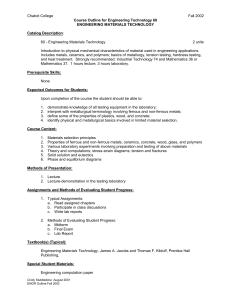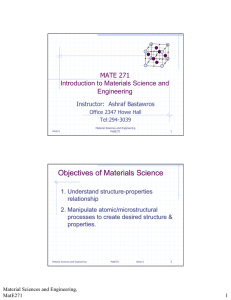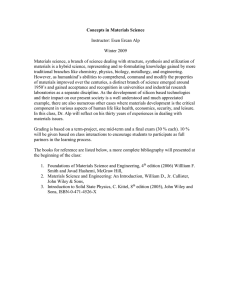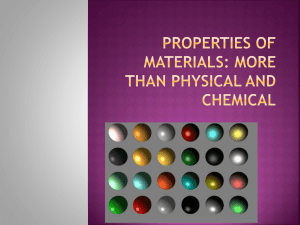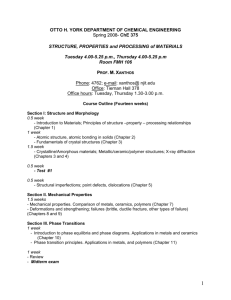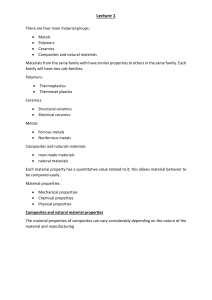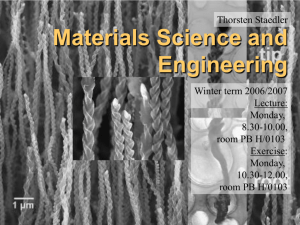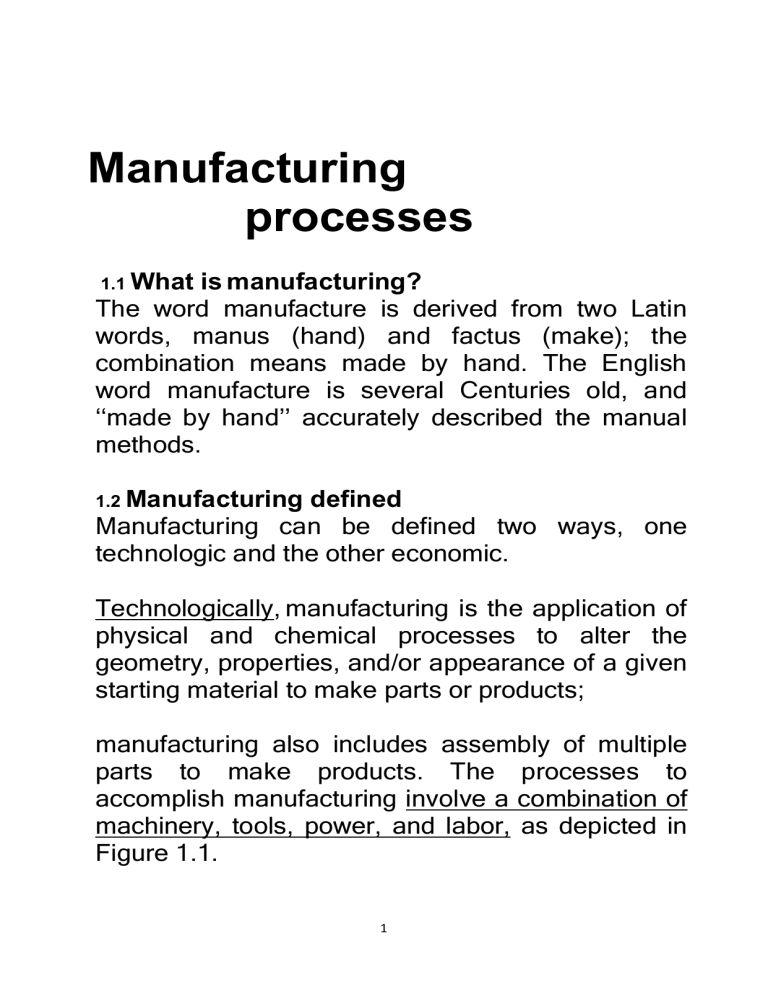
Manufacturing processes 1.1 What is manufacturing? The word manufacture is derived from two Latin words, manus (hand) and factus (make); the combination means made by hand. The English word manufacture is several Centuries old, and ‘‘made by hand’’ accurately described the manual methods. 1.2 Manufacturing defined Manufacturing can be defined two ways, one technologic and the other economic. Technologically, manufacturing is the application of physical and chemical processes to alter the geometry, properties, and/or appearance of a given starting material to make parts or products; manufacturing also includes assembly of multiple parts to make products. The processes to accomplish manufacturing involve a combination of machinery, tools, power, and labor, as depicted in Figure 1.1. 1 Manufacturing is as a sequence of operations. Each operation brings the material closer to the desired final state. Economically, manufacturing is the transformation of materials into items of greater value by means of one or more processing and/or assembly operations. The key point is that manufacturing adds value to the material by changing its Shape or properties, or by combining it with other materials that have been similarly altered. The material has been made more valuable through the manufacturing operations performed on it. When iron ore is converted into steel, value is added. When sand is transformed 2 into glass, value is added. When petroleum is refined into plastic, value is added. And when plastic is molded into the complex geometry of a patio chair, it is made even more valuable. The words manufacturing and production are often used interchangeably. 1.3 Importance of manufacturing processes Manufacturing may produce discrete products, meaning individual parts or pieces of parts or it may produce continuous products. Nails, gears, steel balls, beverage cans and engine blocks are example of discrete products. Metal or plastic sheet, wire, hose and pipe are continuous products. Because a manufactured item has undergone a number of changes during which raw material has become a useful product 3 it has added value, defined as monetary worth in terms of price. For example, clay has a certain value when mined. When the clay is used to make a ceramic dinner plate, cutting tool, or electrical insulator, value is added to the clay; similarly, a wire coat hanger or a nail has added value over and above the cost of a piece of wire. 1.4 Classifications of manufacturing processes Most of the metals used in industry are obtained as ores. These ores are subjected to a suitable reducing process which gives the metal in a molten form. This molten metal is poured into moulds to give commercial casting, called ingots. These ingots are further subjected to one or more processes to obtain usable metal products of different shapes and sizes. All the further processes used (Fig.1.2) for changing the ingots into usable products can be classified as follows: 1.4.1 Primary Shaping Processes These processes are of two types. 4 Some of these finish product to its usable form whereas others do not, and require further working to finish the component to the desired shape and size. Casting needs remelting of ingots in cupola or some other foundry furnace and then pouring of this molten metal into metal or sand moulds to obtain the castings. The products obtained through this process may or may not be required to undergo further operation; depending upon the function they have to perform. Many operations like cold rolling die casting, metal spinning and wire drawing etc., lead to the production of directly useful articles. The common operations are: (1) Casting (2) Forging (3) Rolling (4) Bending (5) Drawing (6) Shearing (7) Spinning (8) Electroforming 5 1.4.2 Machining Processes A fairly large number of components are not finished to their usable shapes and sizes through the primary processes. These components are further subjected to one or more of the machining operation called SECONDARY PROCESSES, to obtain the desired shape and dimensional accuracy. The secondary operation are mainly necessary when a very close dimensional accuracy is required or some such shape is desired to be produced which is not possible through primary operations. These operations require the use of one or more machine tools, various types of cutting tools and cutters, marking and measuring instruments, testing devices and gauges etc. of which a combined application leads to the desired dimensional control. The common machining performed for this purpose are the following: (1) Turning (2) Threading (3) Drilling (4) Shaping (5) Sawing (6) Grinding 6 Fig.1.2. Classification processes of manufacturing 1.4.3.Joining Processes These processes are used for joining metal parts/fabrication work. Such requirement usually occurs when larger lengths of standard section are required. These processes also enable 7 temporary or permanent type of fastening. Most of the processes are require heat for joining of metal pieces. The common processes falling in this category are: (1) Welding (2) Soldering (3) Brazing (4) Riveting (5) Screwing (6) Pressing 1.4.3 Surface Finishing Processes These processes are metal removing processes, in any case as they are primarily intended to provide a good surface finish to the metal surface. Thus, these processes will not affect any appreciable variation in dimensions. The common processes are as following: (1) Buffing (2) Polishing (3) Sanding (4) Electroplating 8 1.5 Selecting Manufacturing Processes: As example for processing methods for materials: 1. Casting 2. Forming and shaping 3. Machining 4. Joining 5. Micromanufacturing and nanomanufacturing 6. Finishing 9 10 11 1.5.1 Part Size and Dimensional Accuracy • Size, thickness and shape complexity of a part have a major bearing on the process selected The size and shape of manufactured products also vary widely Fig.1.3. Size/shape of the process 1.5.2 Manufacturing ▪ and Operational Costs Lead time required to begin production and the 12 tool and die life are of major importance. ▪ Quantity of parts and production rates determine the processes that are used and the economics of production. 1.5.3 Net-Shape Manufacturing Additional finishing operations might be needed for finished parts or products to desired specifications. 1.6 The main responsibilities of the manufacturing engineers: a) Plane the manufacturing of the product and the processes to be utilized, this function requires a through knowledge of product, its expected performance and specification. b) Identify machines, requirement, and tools to carry out the plan. c) Interact with design and materials engineers to optimize productivity and minimize product costs. d) Cooperate with industrial engineers for machine arrangements, material-handling, new technologies….etc 13 Classification Of Engineering Materials, And Their Properties: 1] Material classification: There are different ways of classifying materials. 1 2 1. Metals and alloys; 2. Ceramics, glasses, and 3. Polymers (plastics); glass-ceramics; 4. Semiconductors 5. Composite materials 1-Metals and Alloys: Metals and alloys include steels, aluminum, magnesium, zinc, cast iron, titanium, copper, and nickel. An alloy is a metal that contains additions of one or more metals or non-metals. In general, metals have good electrical and thermal conductivity. Metals and alloys have relatively high strength, high stiffness, ductility or formability, and shock resistance. They are particularly useful for structural or loadbearing applications. Alloys provide improvement in a particular desirable property or permit better combinations of properties. 2-Ceramics: Ceramics can be defined as inorganic crystalline materials. Beach sand and rocks are examples of naturally occurring ceramics. Advanced ceramics are used in substrates that 3 house computer chips, sensors and capacitors, wireless communications, inductors, and electrical insulation. Some ceramics are used as barrier coatings to protect metallic substrates in turbine engines. Ceramics are also used in such consumer products as paints, and tires, and for industrial applications such as the tiles for the space shuttle. Traditional ceramics are used to make bricks, tableware, toilets, bathroom sinks, refractories (heatresistant material), and abrasives. In general, ceramics do not conduct heat well; they must be heated to very high temperatures before melting. Ceramics are strong and hard, but also very brittle. We normally prepare fine powders of ceramics and convert these into different shapes. New processing techniques make ceramics sufficiently resistant to fracture that they can be used in load-bearing applications, such as impellers in turbine engines. Ceramics have compression. exceptional 4 strength under 3-Glasses and Glass-Ceramics: Glass is an amorphous material, often, but not always, derived from a molten liquid. The term “amorphous” refers to materials that do not have a regular, periodic arrangement of atoms. The fiber optics industry is founded on optical fibers based on high purity silica glass. Glasses are also used in houses, cars, computer and television screens, and hundreds of other applications. Glasses can be thermally treated (tempered) to make them stronger. Forming glasses and nucleating (forming) small crystals within them by a special thermal process creates materials that are known as glass-ceramics. Zerodur™ is an example of a glass-ceramic material that is used to make the mirror substrates for large telescopes (e.g., the Chandra and Hubble telescopes). Glasses and glass-ceramics are usually processed by melting and casting. 4-Polymers: Polymers are typically organic materials. They are produced using a process known as polymerization. Polymers typically are good electrical and thermal insulators although there are exceptions such as the 5 semiconducting polymers. Although they have lower strength, polymers have a very good strength-to-weight ratio. They are typically not suitable for use at high temperatures. Many polymers have very good resistance to corrosive chemicals. Polymers have thousands of applications ranging from bulletproof vests, compact disks (CDs), ropes, and liquid crystal displays (LCDs) to clothes and coffee cups. Thermoplastic polymers, in which the long molecular chains are not rigidly connected, have good ductility and formability; thermosetting polymers are stronger but more brittle because the molecular chains are tightly linked (Figure 2-1). Polymers are used in many applications, including electronic devices. Thermoplastics are made by shaping their molten form. Thermosets are typically cast into molds. Plastics contain additives that enhance the properties of polymers. Figure 2-1 Polymerization occurs when small molecules, represented by the circles, combine to produce larger 6 molecules, or polymers. The polymer molecules can have a structure that consists of many chains that are entangled but not connected (thermoplastics) or can form three-dimensional networks in which chains are cross-linked (thermosets) 7 5-Semiconductors: Silicon, germanium, and gallium arsenide-based semiconductors such as those used in computers and electronics are part of a broader class of materials known as electronic materials. In some semiconductors, the level of conductivity can be controlled to enable electronic devices such as transistors, diodes, etc., that are used to build integrated circuits. In many applications, we need large single crystals of semiconductors. These are grown from molten materials. 6-Composite Materials: The main idea in developing composites is to blend the properties of different materials. These are formed from two or more materials, producing properties not found in any single material. Concrete, plywood, and fiberglass are examples of composite materials. Fiberglass is made by dispersing glass fibers in a polymer matrix. The glass fibers make the polymer stiffer, without significantly increasing its density. With composites, we can produce lightweight, 8 strong, ductile, temperature-resistant materials or we can produce hard, yet shock-resistant, cutting tools that would otherwise shatter. Advanced aircraft and aerospace vehicles rely heavily on composites such as carbon fiberreinforced polymers (Figure 2-2). Sports equipment such as bicycles, golf clubs, tennis rackets, and the like also make use of different kinds of composite materials that are light and stiff. Figure 2-2 The X-wing for advanced helicopters relies on a material composed of a carbon fiber reinforced polymer. (Courtesy of Sikorsky Aircraft Division – United Technologies Corporation.) 9 2] Material properties: So what are these properties? Some, like density (mass per unit volume) and price (the cost per unit volume or weight) are familiar enough. Think first of those that have to do with carrying load safely—the mechanical properties. 1- Mechanical properties Materials with high E, like steel, are intrinsically stiff; those with low E, like polyethylene, are not. The steel ruler bends elastically, but if it is a good one, it is hard to give it a permanent bend. Permanent deformation has to do with strength, not stiffness. The ease with which a ruler can be permanently bent depends, again, on its shape and on a different property of the steel— its yield strength, σy. Materials 10 with large σy, like titanium alloys, are hard to deform permanently even though their stiffness, coming from E, may not be high; those with low σy, like lead, can be deformed with ease. When metals deform, they generally get stronger (this is called ‘work hardening’), but there is an ultimate limit, called the tensile strength, σts, beyond which the material fails (the amount it stretches before it breaks is called the ductility). One more. If the ruler were made not of steel but of glass or of PMMA (Plexiglas, Perspex), as transparent rulers are, it is not possible to bend it permanently at all. The ruler will fracture suddenly, without warning, before it acquires a permanent bend. We think of materials that break in this way as brittle, and materials that do not as tough. There is no permanent deformation here, so σy is not the right property. 11 The resistance of materials to cracking and fracture is measured instead by the fracture toughness, K1c. Steels are tough—well, most are (steels can be made brittle)—they have a high K1c. Glass epitomizes brittleness; it has a very low K1c. Figure 1.2(d) suggests consequences of inadequate fracture and toughness. We started with the material property density, mass per unit volume, symbol ρ. Density, in a ruler, is irrelevant. But for almost anything 12 Minimizing weight has much to do with clever design is equally to choice of material. Aluminum has a low density, lead a high one. If our little aircraft were made of lead, it would never get off the ground at all (Figure 1.2(e)).These are not the only mechanical properties, but they are the most important ones. Figure 2-3 2.Thermal properties The properties of a material temperature, usually for the worse. change with Its strength falls, it starts to ‘creep’ (to sag slowly 13 over time), and it may oxidize, degrade or decompose (Figure 2.4). There is a limiting temperature called the maximum service temperature, Tmax, above which its use is impractical. Stainless steel has a high Tmax—it can be used up to 800°C; most polymers have a low Tmax and are seldom used above 150°C. Figure 2-4 14 Most materials expand when they are heated, but by differing amounts depending on their thermal expansion coefficient, α. Metals do with two thermal properties of the material: thermal conductivity and heat capacity. The first, thermal conductivity, λ, measures the rate at which heat flows through the material when one side is hot and the other cold. Materials with high λ are what you want if you wish to conduct heat from one place to another, as in cooking pans, radiators and heat exchangers; Other property—heat capacity, Cp—matters. High heat capacity materials—copper, for instance— require a lot of heat to change their temperature; low heat capacity materials, like polymer foams, take much less. 15 16 Chemical properties Products often have to function in hostile environments, exposed to corrosive fluids, to hot gases or to radiation. Damp air is corrosive, so is water; the sweat of your hand is particularly corrosive, and of course there are far more aggressive environments than these. If the product is to survive for its design life it must be made of materials—or at least coated with materials—that can tolerate the surroundings in which they operate. Figure 2.6 illustrates some of the commonest of these: fresh and salt water, acids and alkalis, organic solvents, oxidizing flames and ultraviolet radiation. We regard the intrinsic resistance of a material to each of these as material properties, measured on a scale of 1 (very poor) to 5 (very good). 2- Figure 2-6 17
